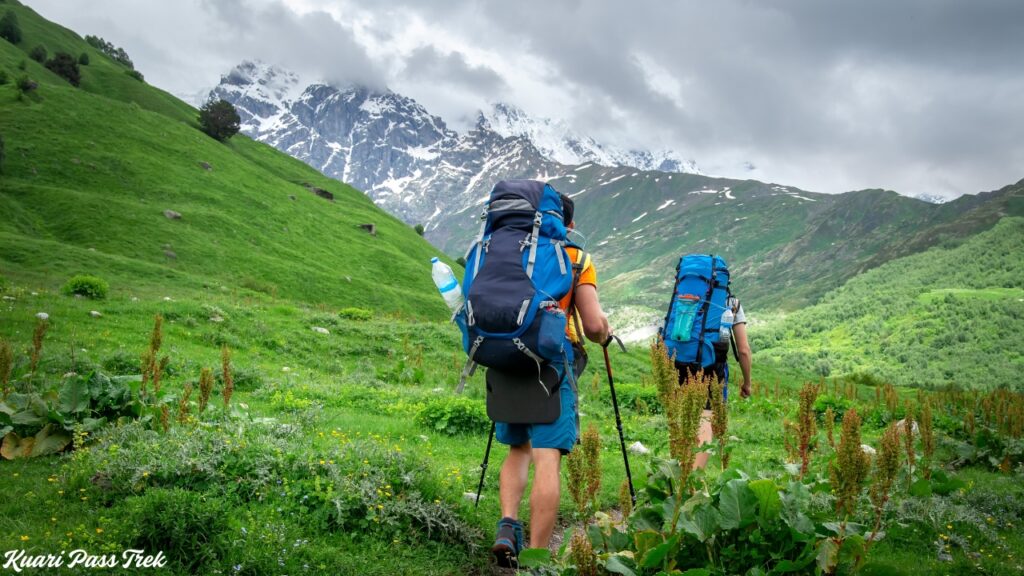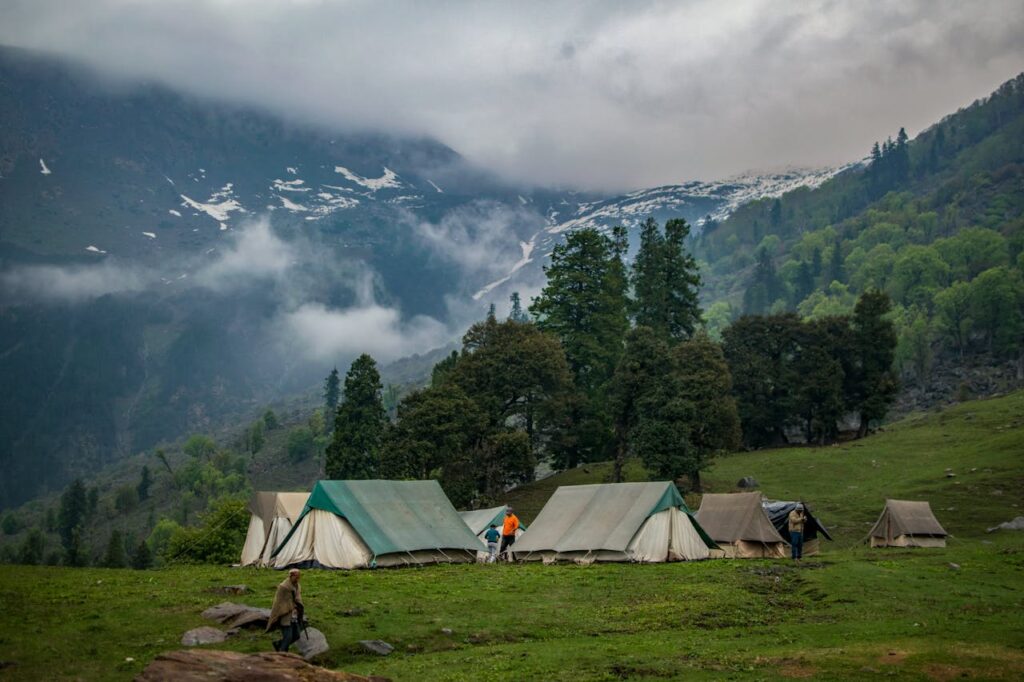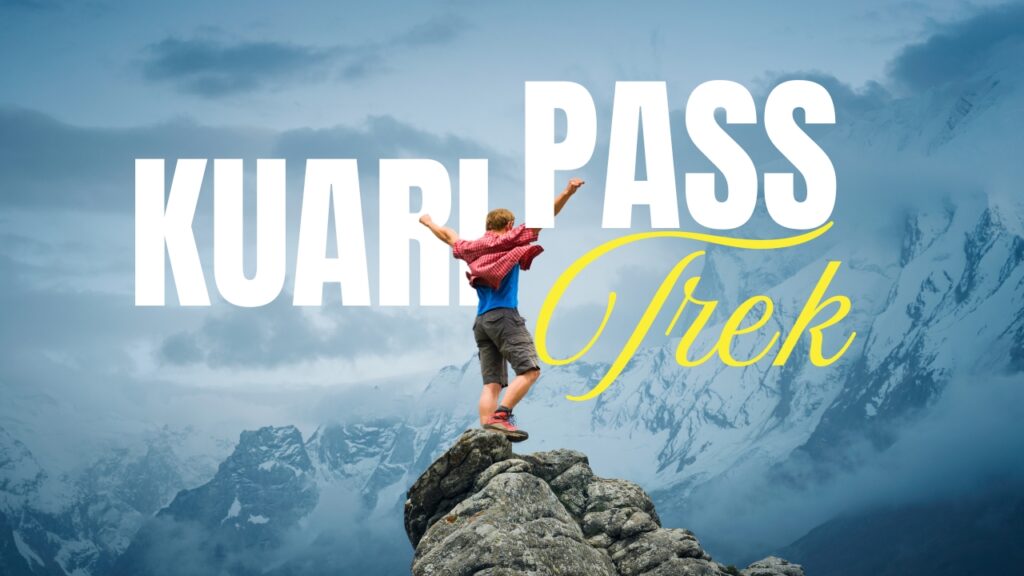Table of Contents
Kuari Pass Overview
Kuari Pass : Hidden far deep in the heart of the Garhwal Himalayas, the Kuari Pass Trek—also popularly known as “Curzon’s Trail”—an absolute paradise destination for mountain addicts, nature seekers, and beginners trekkers. Situated in the Chamoli district of Uttarakhand, this hallowed Himalayan trek gives you an incomparable journey through the thick oak and rhododendron of hillsides, huge alpine meadows (bugyals) and along some of the most beautiful stretches of snow covered ridgeline you’ve ever seen.
Standing at an elevation of around 12,750 feet (3,900 meters), Kuari Pass is a natural balcony offering unobstructed views of some of India’s most magnificent and revered Himalayan peaks. The panoramic views of the surrounding high peaks and ranges of Nanda Devi second highest peak of India, Dronagiri, Kamet, HathiGhoda Parvat, and Trishul (above 23,000 ft.) is stressful treating and captures the imagination. Picture-perfect panoramas and unadulterated settings make it one of the best viewpoints in all of Uttarakhand.
Kuari Pass Trek: Perfect for Beginners, Beloved by Experts

Unlike a lot of highaltitude treks which demand weeks of acclimatization and roughit out experience, the kuari pass trek is a delightful mix of easy accessibility and at the same time fulfof adventure. With a steady pace of five to six days, itʼs an ideal beginnersʼ trek in the Himalayas, yet with plenty of variety and altitude gain to satisfy even experienced trekkers.
Trail Grade: Easy to Moderate
Total Distance: ~33 km
Height: Max Altitude 12,750 ft (at Kuari Pass summit)
When to Go Best Season.Spring (Mar–Apr) & Autumn (Sep–Nov); Winter (Dec–Feb) if you love snow.
🌿 A Tapestry of Landscapes
The trek passes through a diverse range of alpine ecosystems:
At Lower Altitudes: Going through quiet Garhwali villages, terraced fields and whispering pine forests.
Mid Elevations: Going higher, you’ll enter rhododendron and oak forests blooming out in spring or covered in snow during winter.
Higher Camps: Panoramic meadows such as Gorson Bugyal unfold with unlimited views and otherworldly sunrises. During the winter, these meadows turn into snowfields.
Every segment of the trail is a word, varying in terms of habitat and ecological community, which contributes to the magic of the trail as a whole.
📍The Legacy and Cultural Connection of Curzon
The alternative name for the trail—Curzon’s Trail—harks back to the early 1900s when Lord Curzon trekked this trail, mesmerised by the landscape around it. His was the name ever since associated with the path that looks now as peaceful and beautiful as when he made it. Today’s trekkers still shadow a variant of the same route, connecting history with modern adventure.
On the way, you will also come across Himalayan shepherds (Gaddis), ancient stone temples and grazing flocks that add a cultural aspect to the experience.
🧭Trek The Himalayas & Others Organizers
Guided Kuari Pass treks are facilitated by several well known trek organizers. Trek The Himalayas (TTH) is one of the best companies for the following few reasons:
Itineraries created by professionals
Local guides and trek leaders with years of experience
Quality meals and camping equipment
Round trip logistics including forest permits and safety briefings
Why Trek Kuari Pass?
✅ Perfect mix of forest, meadow and highaltitude terrain
✅ Some of India’s best mountain views
✅ Great for beginners but super rewarding
✅ Yearround trek ( except monsoon )
✅ Deep cultural and historical roots
The Kuari Pass Trek isn’t just a trail; it’s a gateway into the heart of the Indian Himalayas, a journey you’ll continue to remember long after you’ve returned home. If you’re looking for detachment, motivation or your first big Himalayan tour, Kuari Pass ensures one of the most memorable winter treks in India.
🌄 Highlights of the Kuari Pass Trek

Rupin Pass One of the best treks for beginners to the Himalayas, this trek is great not only for its jawdropping views, but for it’s also splendid natural diversity available as you ascent the route. Here are some of its key features:
🏔️ 1. Panoramic View Outstanding of Himalayas Giant
Amongst the most beautiful aspects of the Kuari Pass trek is the inspiring view of most or the higher peaks in the Himalaya. From the top of Kuari Pass, trekkers are rewarded with an amphitheater of snow-frosted mountains that appear close enough to touch. These include:
Nanda Devi (7,816 m) – Second highest mountain in India, the queen of the scene.
Dronagiri – A mysterious & majestic mountain Dronagiri is a divinely beautiful peak, albeit quite challenging.
Kamet, Hathi Ghoda, Chaukhamba, Trishul – All iconic peaks, with equally iconic ridgelines.
The view is particularly stunning at sunrise and sunset, when the peaks turn a golden pink or orange. It is frequently referred to by trekkers as the time when they really fall in love with the Himalayas.
🌳 2. Magical Forests and the Blooms of the Rhododendron
The trail starts in heavy stands of mixed woods dominated by tall oak, maple and rhododendron. Between March and April the full blooming of the rhododendrons creates a multicolored flower tunnel. These forests aren’t just pretty to look at, either, they’re teeming with biodiversity.
You may also see the odd rare bird species such as Himalayan monals (the state bird of Uttarakhand), eagles, or signs of mountain animals like the musk deer or Himalayan tahr.
Winter turns the same woods into a Narnialike landscape cloaked in deep snow, where the only sound is the crunch of snow beneath your boots.
🌿 3. Vast Alpine Meadows (Bugyals)
What makes the Kuari Pass trek truly special are the alpine meadows, or bugyals as the locals fondly refer to them. These expansive, rolling, grasslands are high mountain plains with expansive views to the surrounding peaks.
Gurson Bugyal is arguably the best-known of the trail, loved for its sweeping open views, particularly in the autumn and early winter when the skies are clear as a bell.
The meadows are a great place to camp, offering spectacular sunrises, grazing sheep and goats, and wildflowers in full bloom in warmer months.
🧭 4. Significance – The ”Curzon Trail”
The Kuari Pass was made famous by Lord Curzon, British Viceroy of India, who explored the region in 1905. Ultimately his journey would give the trail its second name- “Curzon’s Trail”. This historical connection is truly unique, as you follow in the footsteps of the early surveyors and adventurers.
🏡 5. Culture at the Villages of the Himalayas
The trek starts and meanders through a number of old Himalayan villages, such as Tugasi, Gulling and Karchi along the way. These provide an insight into living of the local Bhotiya and Garhwali tribes.
You’ll be able to observe terraced farms and stone houses, and possibly even meet locals who might show you a friendly smile, share their stories or even some made at home food.
And a rare chance to observe sustainable mountain life and experience Himalayan hospitality.
✨ 6. A Trek for All Seasons
Different moods of Kuari Pass Kuari Pass has a persona for each season:-
Winter: Snowy scenes and powdery trails and frozen pine forests.
Spring: A burst of color in the form of blooming flowers and greenery.
Fall: Cold air, perfect mountain views, and golden hillsides.
So no matter when you go, you will have a magical experience visualized just a little differently.
Trek Itinerary Overview: Step by Step Through the Himalayas

The Kuari Pass trek is generally 6 days long and a couple of days extra are required to travel to and fro from the base camp. Every day we experience a new variety of terrain—namely, cozy Himalayan villages, dense oak forests, spacious alpine meadows, and snow-covered passes. Here, day by day, is a summary to help you get a sense of the adventure you will undertake:
📍Day 1 : Arrival at Joshimath (6,150ft)
Drive: Rishikesh – Joshimath Approx. 9–10 hours (255 km)
Sightseeing Points: Journey past the confluence of Alaknanda at Devprayag and the confluence of Mandakini at Rudraprayag
Stay: Guesthouse/hotel at Joshimath
Tip: Arrive early to sleep and acclimatize; this is your entryway to the Garhwal Himalayas.
🥾 Day 2: Gulling to Dhak Village and back to Gulling on the same day
Drive: Joshimath – Dhak (45 Mins)
Trek: Dhak (6890 ft) – Gulling (9800 ft) – Approx. 5 km / 45 hours
Highlights of the Trail: Moderate climb to mountain villages, terraced farms and rhododendron forests
Highlights: First glimpse of Dronagiri peak, overnight in forest campsite
Overnight: Tented camp site or ecohut
🌲 Day 3: Gulling to Tali Forest Camp
Trek: Gulling to Tali (3,300 m) – Approx. 5 km / 4 hours
Trail Attributes: Easy climb into very dense oak and conifer forest
Highlights: Rhododendron blossoms (spring), snowcovered trees (winter), peaceful forest camping
Spend the night: Forest tented camp with low in light pollution – great for star-gazing
🏔️ Day 4: Tali to Kuari Pass Summit and back to Tali
Day 06: Kuari Pass (12,750 ft) back Tali -Around 11–12 km return / 89 hours
Trail Highlights: Trek through alpine bugyals (Gorson Bugyal) and there is a good view of the deep wooded valleys.
Summit Views : The Magnificent Nanda Devi, Baljuri, Dunagiri, Bethartoli, Nilkanth, and Rishikot;;; Peaks like Nandaghunti, Dronagiri and Kamet;; Peaks like Chaukhamba and more
Highlights: This is THE day – sunrise hike suggested for gold peak glow!
Stay: Return to Tali campsite
⛰️ Day 5: Tali to Joshimath via Auli
Trek : Tali to Auli (9,390 ft) – Approx. 6 km / 4 hours
Transport: Auli to Joshimath by cable car or road.
Trail Features: Auli Meadow, scenic downhill trek, view of Ski slopes
What not to miss: This is one of the most beautiful ends to any trek in India
Stay: Guesthouse in Joshimath
🚗 Day 6: Joshimath – Rishikesh
Drive: 9–10 hours
Route: By river valleys and confluences—best to ponder on the journey!
End Point: Rishikesh (overnight stay or can proceed further)
📝 Optional Addons:
Auli Skiing Extension (Winters only): Extend your stay for a day at Auli and experience the snow slopes.
Valley of Flowers or Visit to Badrinath Temple (Summer): Add a pinch of culture or spirituality to your adventure.
✅ Quick Summary Table of Kuari Pass Trek
| Day | Route | Elevation Gain | Highlights |
|---|---|---|---|
| 1 | Rishikesh → Joshimath | – | Scenic drive, overnight rest |
| 2 | Joshimath → Gulling via Dhak | ↑ ~3,600 ft | Mountain villages, forest entry |
| 3 | Gulling → Tali | ↑ 700 ft | Oak forests, rhododendrons |
| 4 | Tali → Kuari Pass → Tali | ↑ ~2,200 ft | Summit day, Himalayan vistas |
| 5 | Tali → Auli → Joshimath | ↓ descent | Meadows, ski views, cable car |
| 6 | Joshimath → Rishikesh | – | Return drive |
Whether you’re new to the game or an experienced trekker, this well-timed itinerary gives you ample time to acclimatize, take in the awe-inspiring views, and experience the true essence of the Garhwal Himalayas.
Best Time to Visit Kuari Pass Trek

The best part about the Kuari Pass trek is – it’s a different trail every season. Be it the snow laden forest during winter, blooming Rhododendrons during spring or cristal clear sky during autumn, every season has its own charm.
Now are some of the detailed specifics about the best time to visit Kuari Pass and what you can expect in each season:
🌨️ Winter (December through February): Snowy Wonderland
If Pristine snowy peaks and Himalayan snow experience, is on your mind, then winter is the best time to head for Kuari Pass. The way turns into a fairy-tale forest in the thick snow covering the forests, meadows and camp sites.
Landscape: Snowclad and oak forests, icy mountain streams, and snow washed bugyals (pastures).
Experience: It’s a wonderful season for photographers and snow lovers. Camps are frequently set up on snow and the views of the peaks are striking under clear winter skies.
Difficulty Level: It is a tad more difficult because of snow and cold. You can expect subzero nights, and should pack accordingly with layering clothes and bringing good quality gear.
Best For : Adventure junkies and first time snow trekking experience.
🌸Spring: Rhododendron Bloom and Fresh Trails (March – April)
Spring is the time when the snow melts, the forest fills up with color, and life returns to the trail. There are rhododendron trees which bloom a vivid pink and red and the weather is getting mild.
Scenery: Vibrant forests, green meadows and trickling mountain streams. It remains cold on top of the mountains.
THE EXPERIENCE Thoughts: It’s the best of both worlds — fresh greenery down below and snow capped peaks in the background. Days are sunny and nights are cold, but not prohibitively so.
Challenge Level: Moderate. The pass could still have less than clear trails but hiking to be fair is better.
Who Goes: Nature enthusiasts and novoice trekkers who are looking for a lively and balanced trip.
🍁 Autumn (September-November): Blue Skies & Golden Scenes.
Clear as next sentence but probably better that postmonsoon. Dried grasslands and clearcut mountain vistas turn the landscape gold.
Landscape: Crystal clear sky, fresh mountains air, golden meadows, and a golden rising sun.
Experience: The best time for photography and to enjoy longrange views of Himalayan peaks as Nanda Devi, Dronagiri etc. Less snow on the trail means it is easier to hike.
Challenge Rating: Simple to moderate. More Info Weather Enjoyable during the day and cold at night.
Good For: Trekkers who want photographic opportunities, views and an ambling trail.
🌧️ Monsoon (mid-July to early September): Not Ideal
During the monsoon season, which runs from June to September, the area receives heavy rains that cause the mountain trails to become extremely slippery and causes landslides. Leeches, slippery roads and lack of visibility also render trekking during this period hazardous.
Scenery: Lush vegetation, waterfalls and mostly clouded peaks.
Obstacles: Trails may be muddy, views may be obscured and routes may be closed.
Best Time To Trek: Not at all! Not safe or enjoyable.
✅ Summary: When Should You Go?
| Season | Snow Experience | Best Views | Blooming Flowers | Ideal For |
|---|---|---|---|---|
| Winter | ✅ | ✅ | ❌ | Snow lovers, adventure seekers |
| Spring | ⚠️ (at high points) | ✅ | ✅ | First-time trekkers, nature lovers |
| Autumn | ❌ | ✅✅ | ❌ | Photographers, beginners |
| Monsoon | ❌ | ❌ | ✅ (lushness) | Not recommended |
Preparation and Essentials for the Kuari Pass Trek

The Kuari Pass trek, though easy by Himalayan standards, goes deep into the Himalayas — where the weather, the terrain, and the elevation contend with even the most experienced of trekkers. Prep is very important in keeping your hike a safe, comfortable, and joyful one.
Here’s what you need to know before tying up your boots:
💪 Fitness: Build Endurance, Not Speed
While the Kuari Pass trek doesn’t involve any technical climbing, it does involve hiking for 5–6 days over uneven ground, uphill and, if you’re unlucky, on snow-covered trails — sometimes at a height of almost 12,750 feet (3,900 metres).
Fitness Tips:
Cardio training is crucial. Jogging, brisk walking, swimming, bicycling and stair climbing 4-5 days a week will lead to increased lung capacity and endurance.
Add leg and core work like squats, planks and lunges.
Do long walks or hikes with a backpack to mimic trek conditions.
Acclimatization is scripted into the itinerary, but that doesn’t mean you can’t help it along: Stay hydrated, and don’t push too hard, too fast.
Objective: You can comfortably walk 6–8 km daily with a day pack.
🎒 Gear Checklist: Pack Smart, Keep Warm
Himalayan weather is fickle — a sunny morning can become a cold, or even snowy evening. Having the right gear can matter a great deal for your comfort and safety.
✅ Must Wear Clothing & Footwear:
Trekking shoes that are waterproof and provide good ankle support with a good grip.
Thermal polypropylene long underwear (the thickest polypro you can find for both top and bottom): to keep you warm.
Fleece or down jacket (insulation)
Windproof, water-resistant shell/jacket
Trekking pants (avoid jeans)
Thermal socks, gloves and toques/hat
Poncho or rain coat, if you have it.reject the teaching of a mother tongue of a minority language.
✅ Accessories:
Poles – in useful on steeper snowier parts); Water- Trekking pole(s)- Optional if needed for steep and snow covered parts.
Flashlight (or torch) – and some spare batteries
Sunglasses & sunscreen — it’s a highaltitude UV environment!
Bottle or pack – keep your body hydrated!
Daypack (20-30L) – to carry supplies for the day
Personal medical kit – bring pain killers, altitude (consult a doctor) band aids and medication if needed.
💡 Pro Tip: Travel lightly, but wisely. The weather is fickle, especially in the winter or early spring. Layering is key.
📝 Permits & Logistics: The Professionals Can Handle It

Trekking in the Kuari Pass region is subject to entry permits for forest and camping areas that can be obtained from the local authorities and the forest department of Uttarakhand. These permits are necessary and verified at multiple locations on the trail.
The good news?
If you’re going through a well-known trek operator—like TTH (Trek The Himalayas) — then they manage:
Permits from the forest and environment
Camping arrangements
Guide and porter services
Meals and emergency response
Transport to (and from) base city (e.g. Rishikesh or Joshimath) to trail head.
Trek The Himalayas are one of the most reputable Himalayan trek in India and our set departure treks assurance (scrutinize more) read more reliable landscape, proficient trek leaders and allinone package (to ensure safety, comfort and merriment) for firsttimers accomplished trekkers.
🔑 Final Tips:
Begin training at least 4–6 weeks in advance.
Wear your walking shoes around to break them in before the trip to avoid blisters.
Pay attention to your trek leader, by the way, on matters of altitude sickness and safety.
Pack thoughtfully — what you bring, you’ll be schlepping on the trail.
By being well-prepared, you’re doing more than just surviving the trek — you’re actually going to be enjoying every step through the lush forests, meadows, and all the way up to the giant summit of the Kuari Pass. Gear up properly, train some and you’ll be rewarded with a once-in-a-lifetime Himalayan experience.
Frequently Asked Questions (FAQs)
1. What is the Kuari Pass Trek?
The Kuari Pass Trek is a trek that boasts of high mountain ranges like the Nanda Devi , Dronagiri , and Kamet , and it is in the Indian state of Uttarakhand . It is also known as the Valley of Gods because of the beautiful and peaceful environment.
2. When is the best time to go for the Kuari Pass Trek?
The Kuari Pass Trek is best to be done between April to June (summer) and September to November (post-monsoon) . The weather is pleasant, and trails are open to provide excellent views of snow-capped mountains and blooming meadows.
3. How challenging is the Kuari Pass Trek?
The Kuari Pass Trek is rated moderate to difficult . This includes challenging climbs, where elevations can reach 12,500 feet or more, and sometimes difficult trails. Although previous treks are good, beginners can manage with good fitness levels and enough enthusiasm.
4. What is the length of the Kuari Pass Trek?
The Kuari Pass Trek is usually 6-7 days (including the drive to and from Haridwar to the start of the trek), around 35-40 km to and fro . The trek has acclimatization days to assist climbers to adjust with high altitudes.
5. Should I go with a guide for the Kuari Pass Trek?
An independent trek is doable, but it is advised to either hire a guide (minimal cost) or trek with a group if it’s the first time. Guides ensure safety, knowledge about the area, and assist in crossing difficult parts of the trail.
6. What to carry for the Kuari Pass Trek?
Essential items include:
Sturdy trekking shoes
Clothes warm (underwear companion jacket with a dress of pile of windbreak)
Trekking poles
Backpack (40-50 liters)
Sunglasses and sunscreen
Water bottles or hydration pack
First aid kit
Snacks and energy bars
Camera to take pictures of views
7. Is it safe for solo travelers to do the Kuari Pass Trek?
Yes, the Kuari Pass Trek is relatively safe for a solo traveler if he/she is fit both physically and mentally. But you should tell someone of your plans, carry a satellite phone or GPS device in your pack, and avoid trekking alone in remote areas.
8. Is there any trekking permit necessary for the Kuari Pass Trek?
Yes, you will probably need permits depending on the route and local ordinances. You need trekking permits to go to protected areas such as forests. Your trek operator or local authorities should be able to help you with the permits.
9. What animals will I be able to spot during the Kuari Pass Trek?
The Kuari Pass area is full of biodiversity. You can see animals including the Himalayan monals (state bird of Uttarakhand ), barking deer , snow leopards (occasionally), and different species of birds. The region is also known for its various flora, such as rhododendrons , oak trees , and alpine meadows .
10. Can I club the Kuari Pass Trek with any other treks in Uttarakhand?
Absolutely! The Kuari Pass Trek is often combined with other nearby treks such as the Roopkund Trek , Valley of Flowers Trek , and Brahmatal Trek . These treks are one of a kind and give you the experience of discovering different sides of Uttarakhand’s natural allure .
Looking to explore more hidden gems and adventure-packed destinations in the Himalayas? Visit Uttarakhand Tours for detailed guides, itineraries, and travel tips on the best treks, hill stations, and cultural experiences across the state. Whether you’re dreaming of snow-covered peaks, serene temples, or vibrant local life, you’ll find everything you need to plan your perfect getaway—all in one place!




i got nice and complete info on this site. thanks